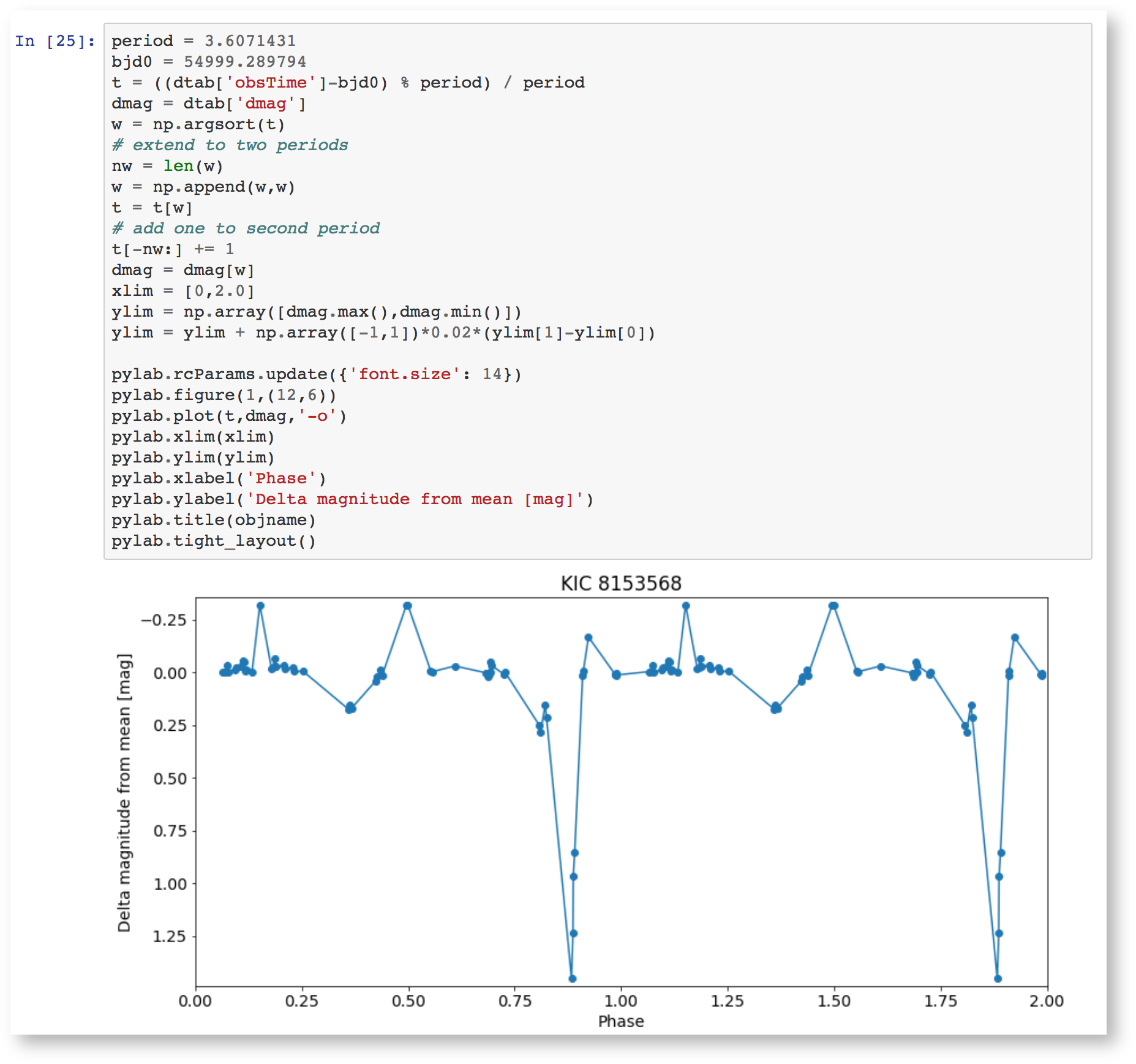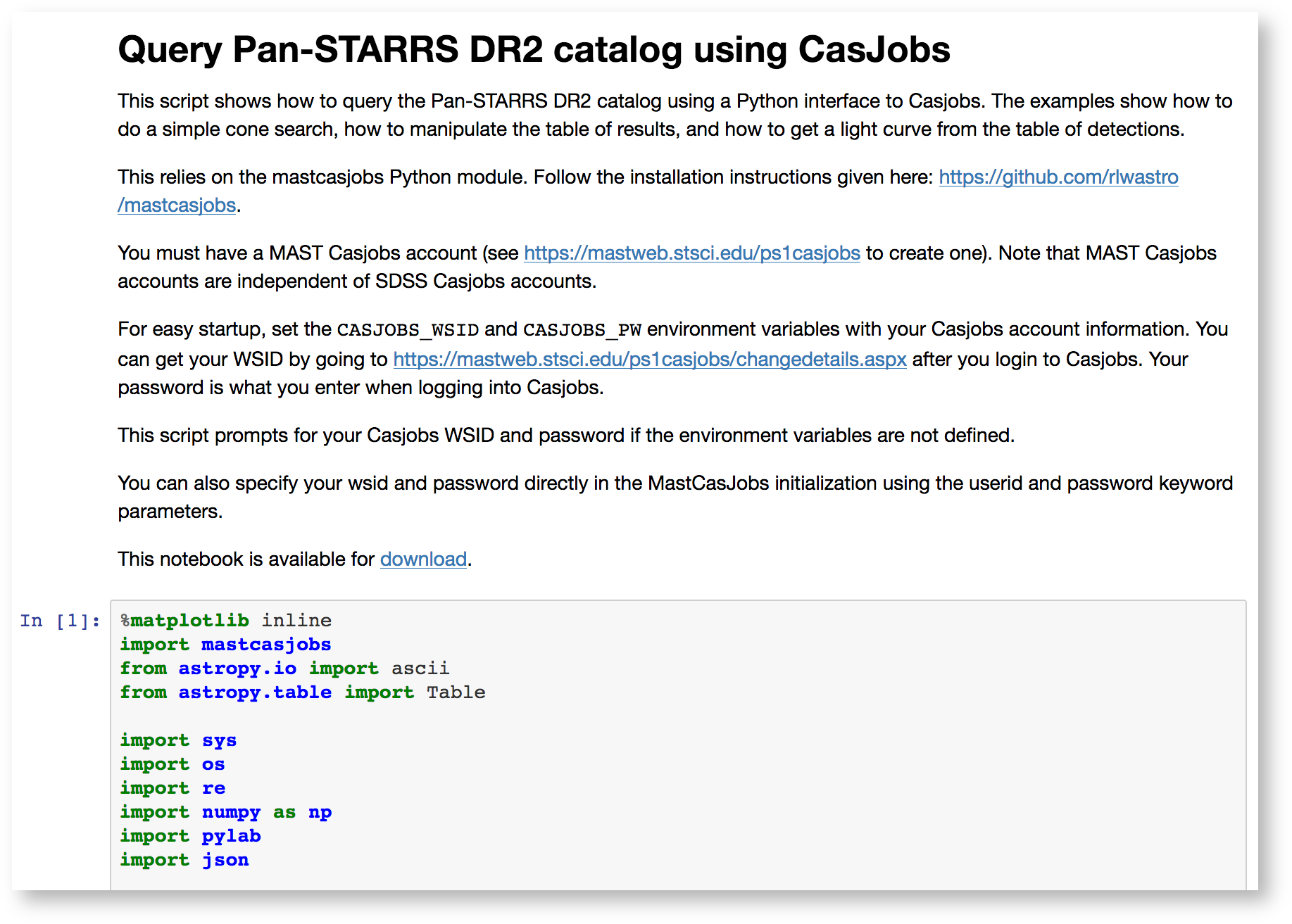Page History
Versions Compared
Key
- This line was added.
- This line was removed.
- Formatting was changed.
| Excerpt |
|---|
Currently the primary access to the PanSTARRS catalog is through database queries using the MAST CasJobs interface, and the primary access to the PS1 images is through the PS1 Image Cutout Service. There is also a simple web form to search the catalog for objects near a sky position and a VO-compatible cone search interface for simple positional searches. A VO TAP service also provides direct SQL query access to the database. Both catalog and image interfaces can be used from scripts. In the future other methods will be added for retrieving PanSTARRS images and catalogs, including more options for the form interfaces and a sophisticated MAST Portal interface that has capabilities of browsing, filtering, plotting, etcThe DR2 search API is fully functional and can be used to search various tables with constraints from any of the table columns. The PS1 images are also accessible via the MAST Portal. Python notebooks are provided with examples of access via various interfaces. |
The starting point for the PS1 data archive is at Pan-STARRS1 data archive home page.
| Tip | ||||||
|---|---|---|---|---|---|---|
| ||||||
|
Catalog Access Tools
The PanSTARRS catalog is a large database of the objects and measurements of their properties including astrometry, photometry, and morphology. It includes copious metatdata metadata including links to the images that were used for the various object measurements. (Maybe include some stats on catalog/database size here.)
Search Forms:The total database size for the DR2 release is nearly 150 TB.
Web search form
A simple web form searches the object catalog for objects near a search position.
httpFeatures of the https://
archivepanstarrs/search.phpweb form:
- The form includes a name resolver allowing positions to be specified using object names recognized by SIMBAD or NED.
- The form can search multiple tables from the catalog, including mean objects, stack objects, and detections. Additional tables will be added in the near future.
- A list of target names or positions can be uploaded to search multiple positions at once. (Currently this is relatively slow, but enhancements coming soon will make it much faster.)
- The user can customize the columns returned from the search and can add additional constraints on the search (e.g., using magnitudes or other columns from the catalogs).
- We recommend using the nDetections>=2 constraint when searching the mean objects catalog to reduce the number of spurious objects in the catalog. Such object results from this form can be returned in a variety of formats including HTML table, comma-separated values, etc. The columns returned can also be customized.Currently the form has a single additional parameter to require the results to include only objects with more than one detection (the default is nDetections>1). This is useful to eliminate spurious objects from the catalog, which are usually detected at only a single epoch.
- The search results from this form can be view interactively or downloaded as a comma-separated value file.
- Note: The old web form at https://archive.stsci.edu/panstarrs/search.php remains available but can only be used to search the DR1 catalog. It also lacks many of the filtering capabilities of the new interface. We recommend that all users of the old interface switch to the new interface. Eventually the old interface will be retired.
 Image Added
Image Added
Catalogs API for scripted searches
The search form has an associated
web serviceapplication program interface (API) that can be used for programmatic (scripted) queries to the catalog. The API includes access to all the functionality of the interface, including constraints, selection of columns, etc. It can return the data in various formats including CSV, JSON, VOTables. It also has a metadata query to get a list of the available columns for a particular table. The API can be used for larger queries than the web interface, which is limited to returning 50,000 rows of data.
It is simple to use the API either from a language such as Python or with other command-line tools such as curl.
See our Python Jupyter notebook for the MAST API for simple examples of how to access the PS1 DR2 catalog via the API.
Here is a simple 1-line command using curl to get a csv table of source information from the mean catalog. This searches the PS1 DR2 mean catalog for sources within 0.5 degrees of the position of NGC 6822. It restricts the result to objects with nDetections >= 2 and increases the default limit on the number of sources returned to 500,000. This query executes in less than one minute:
| Code Block | ||
|---|---|---|
| ||
curl 'https://catalogs.mast.stsci.edu/api/v0.1/panstarrs/dr2/mean.csv?ra=296.24059&dec=-14.80343&radius=0.5&pagesize=500000&nDetections.gte=2' > ngc6822.csv |
Easy cross-match using catalogs API
The MAST catalogs interface has a cross-match capability that can be easily used to match lists of source positions. See Easy cross-match with PS1 using a list of source positions for an example.
VO cone search
- Mean object search https://gsss.stsci.edu/webservices/vo/CatalogSearch.aspx?CAT=PS1dr2OBJECTS&RA=<ra>&DEC=<dec-degrees>&SR=<radius-degrees>
- Detection search httpsVO Cone search: http://gsss.stsci.edu/webservices/vo/CatalogSearch.aspx?CAT=PS1V3OBJECTSPS1dr2DETECTIONS&RA=<ra>&DEC=<dec-degrees>&SR=<radius-degrees>
- A generic description of this multi-catalog service is available at httphttps://gsss.stsci.edu/Software/WebServices.htm.
SQL query interface: MAST CasJobs
- httphttps://mastweb.stsci.edu/ps1casjobs
 Image Added
Image Added - The CasJobs interface (which is familiar to users of SDSS) includes built-in Help along with some sample PS1 queries. It also includes links to SQL tutorials.
- The MAST CasJobs interface also provides access to other catalogs including GALEX, Kepler, and the Hubble Source Catalog.
- Note that CasJobs queries can also be executed from Python. See our Python Jupyter notebook for PS1 CasJobs queries for examples of one approach to accessing CasJobs from Python. Note that this notebook does the same queries as the MAST API notebook, so a comparison between the two may help in understanding the relationship between the two interfaces.
SQL query interface: VO TAP
- The VO Table Access Protocol (TAP) interface allows database queries through a SQL-based language. The MAST PS1 TAP interface can be used to query the PS1 database. See the TAP documentation for details about how TAP services work.
- A Jupyter notebook shows how to query the database from Python.
- The PS1 TAP service is also accessible from standard VO tools such as TOPCAT. In TOPCAT, use the VO → Table Access Protocol menu to get a list of list of services, and then search for PS1DR2 to find the TAP service.
Image Access Tools
The PS1 images are available for the five PS1 filters for combined multi-epoch stacked images. and, with DR2, to the single epoch "warp" images.
PS1 Image Cutout Service
- The PS1 Image Cutout Service provides color images, JPEG and FITS cutouts, an interactive image display, and full FITS image retrievals.
- The image cutout service is programmatically accessible to allow downloading either cutouts or full images via a script.
- . There is a simple Python Jupyter notebook that shows how to download images.
MAST Portal
- PanSTARRS images are also accessible via the MAST Portal, which provides both a flexible interactive interface (which integrates the PS1 images with the other MAST holdings include Hubble data).
- The Portal also has a powerful API that provides programmatic access to MAST data holdings.
Moving Target Search
 Image AddedA Python Jupyter notebook that demonstrates how to search for both images and catalog sources that match solar system moving targets is available on the How to search for moving targets in PS1 images and catalogs page.
Image AddedA Python Jupyter notebook that demonstrates how to search for both images and catalog sources that match solar system moving targets is available on the How to search for moving targets in PS1 images and catalogs page.
| Data Retrieval Quick Links | |
|---|---|
| Catalog and Database Access | |
| Search form | |
| VO Cone Search |
|---|
PS1dr2OBJECTS&RA=<ra>&DEC=<dec-degrees>&SR=<radius-degrees> |
| CasJobs |
|---|
| https://mastweb.stsci.edu/ps1casjobs/ | |
| VO TAP | https://vao.stsci.edu/PS1DR2/tapservice.aspx |
|---|---|
| Image Access | |
| Image cutout service | |
